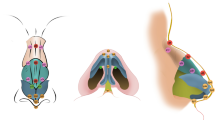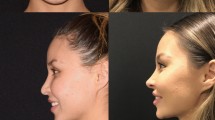Abstract
Background
Though generally safe, injection rhinoplasty with synthetic non-hyaluronic fillers may lead to various deformities, which impose a psychological burden on the patients. As the injected material is technically hard to be fully cleared in the nose, the surgery is primarily chosen to address the patients’ psychological distress caused by injection. Unfortunately, there is a paucity of data regarding patient-reported outcomes of this procedure.
Methods
From August of 2017 to June of 2021, the authors retrospectively reviewed all cases who underwent the foreign material removals by suction curettage after injection rhinoplasties. The relevant demographic, treatment characteristics and complication details were collected. The modified Rhinoplasty Outcome Evaluation (ROE) questionnaires were prospectively completed before and 6 months after the surgery.
Results
Of the 46 patients, four cases developed minor surface irregularities on the nasal dorsum postoperatively; two cases who had recurrent nasal dorsum redness and swelling before the surgery still exhibited the redness with a less degree after the surgery; no patients needed secondary revision. There was a significant improvement in any of patient-reported outcomes at 6-month follow-up, relative to the preoperative baseline scores.
Conclusion
The injected foreign material in the nose could be effectively removed by suction curettage with minimal complications. The patients’ satisfaction and quality of life, which was severely impaired preoperatively, could be significantly improved after the surgery.
Level of Evidence IV
Therapeutic study. This journal requires that authors assign a level of evidence to each article. For a full description of these Evidence-Based Medicine ratings, please refer to the Table of Contents or the online Instructions to Authors www.springer.com/00266.





Similar content being viewed by others
References
Kurkjian TJ, Ahmad J, Rohrich RJ (2014) Soft-tissue fillers in rhinoplasty. Plast Reconstr Surg 133:121e–126e
Radulesco T, De Bonnecaze G, Penicaud M, Dessi P, Michel J (2021) Patient satisfaction after non-surgical rhinoplasty using hyaluronic acid: a literature review. Aesthet Plast Surg 45:2896–2901
Williams LC, Kidwai SM, Mehta K, Kamel G, Tepper OM, Rosenberg JD (2020) Nonsurgical rhinoplasty: a systematic review of technique, outcomes, and complications. Plast Reconstr Surg 146:41–51
Lemperle G, Sadick NS, Knapp TR, Lemperle SM (2010) ArteFill permanent injectable for soft tissue augmentation: II Indications and applications. Aesthet Plast Surg 34:273–286
Rokhsar C, Ciocon DH (2008) Nonsurgical rhinoplasty: an evaluation of injectable calcium hydroxylapatite filler for nasal contouring. Dermatol Surg 34:944–946
Ono S, Ogawa R, Hyakusoku H (2010) Complications after polyacrylamide hydrogel injection for soft-tissue augmentation. Plast Reconstr Surg 126:1349–1357
Trinh LN, Gupta A (2021) Non-hyaluronic acid fillers for midface augmentation: a systematic review. Facial Plast Surg 37:536–542
Kosowski TR, McCarthy C, Reavey PL, Scott AM, Wilkins EG, Cano SJ, Klassen AF, Carr N, Cordeiro PG, Pusic AL (2009) A systematic review of patient-reported outcome measures after facial cosmetic surgery and/or nonsurgical facial rejuvenation. Plast Reconstr Surg 123(6):1819–1827
Carella S, Ruggeri G, La Russa R, Volonnino G, Frati P, Onesti MG (2021) Clinical management of complications following filler injection. Aesthet Plast Surg. https://doi.org/10.1007/s00266-021-02650-4
Daines SM, Williams EF (2013) Complications associated with injectable soft-tissue fillers: a 5-year retrospective review. JAMA Facial Plast Surg. 15:226–231
Alsarraf R (2000) Outcomes research in facial plastic surgery: a review and new directions. Aesthet Plast Surg 24:192–197
Xiao H, Zhao Y, Liu L, Xiao M, Qiu W, Liu Y (2019) Functional/aesthetic measures of patient satisfaction after rhinoplasty: a review. Aesthet Surg J 39:1057–1062
Mills DC, Camp S, Mosser S, Sayeg A, Hurwitz D, Ronel D (2013) Malar augmentation with a polymethylmethacrylate-enhanced filler: assessment of a 12-month open-label pilot study. Aesthet Surg J 33:421–430
Schuster B (2015) Injection rhinoplasty with hyaluronic acid and calcium hydroxyapatite: a retrospective survey investigating outcome and complication rates. Facial Plast Surg 31:301–307
He J, Wang T, Dong J (2020) Classification and management of polyacrylamide gel migration after injection augmentation mammaplasty: a preliminary report. Aesthet Plast Surg 44(5):1516–1521
Cassuto D, Pignatti M, Pacchioni L, Boscaini G, Spaggiari A, De Santis G (2016) Management of complications caused by permanent fillers in the face: a treatment algorithm. Plast Reconstr Surg 138(2):215e–227e
Christensen L, Breiting V, Janssen M, Vuust J, Hogdall E (2005) Adverse reactions to injectable soft tissue permanent fillers. Aesthet Plast Surg 29:34–48
Lee KC, Ha SU, Park JM, Kim SK, Park SH, Kim JH (2006) Foreign body removal and immediate nasal reconstruction with superficial temporal fascia. Aesthet Plast Surg 30:351–355
Acknowledgement
The authors declare that they have no conflict of interest.
Author information
Authors and Affiliations
Corresponding authors
Ethics declarations
Conflict of interest
The authors declare that they have no conflicts of interest to disclose.
Ethical Approval
All procedures performed in this study were in accordance with the ethical standards of our Institutional Ethical Committee.
Informed Consent
Informed consent was obtained from all participants.
Additional information
Publisher's Note
Springer Nature remains neutral with regard to jurisdictional claims in published maps and institutional affiliations.
Rights and permissions
Springer Nature or its licensor holds exclusive rights to this article under a publishing agreement with the author(s) or other rightsholder(s); author self-archiving of the accepted manuscript version of this article is solely governed by the terms of such publishing agreement and applicable law.
About this article
Cite this article
He, J., Bian, W., Yang, J. et al. Surgical Removal of Foreign Material by Suction Curettage After Injection Rhinoplasty: Patient-Reported Outcomes. Aesth Plast Surg 46, 2964–2971 (2022). https://doi.org/10.1007/s00266-022-03103-2
Received:
Accepted:
Published:
Issue Date:
DOI: https://doi.org/10.1007/s00266-022-03103-2




